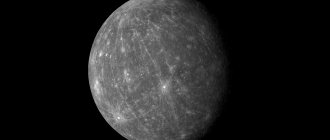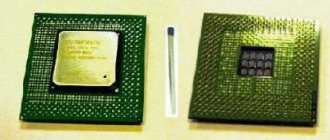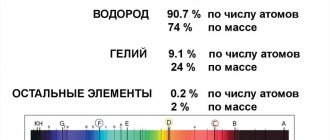There are unusual bodies in the solar system called dwarf planets. These objects are in many ways similar to full-fledged planets, but in some respects they are still inferior to their “big brothers.” Little is known about them and this group is constantly updated with new objects. We will talk about the six currently known dwarf planets of the Solar System, their main features and differences from each other. We’ll also figure out why these celestial bodies cannot claim to be full-fledged planets.
How many dwarf planets are there in the solar system?
This question is still very difficult to answer. Scientists have not yet fully explored the outskirts of our star system, and, according to their calculations, dozens and even hundreds of similar objects may be hiding there. But at the moment, only 6 are officially recognized - Pluto, Ceres, Eris, Haumea, Makemake and Sedna. At the same time, Pluto moved into this group from full-fledged planets, and all the rest - from asteroids of various classes.
Where are the dwarf planets located? The largest concentration of planetary dwarfs and candidates for this title is observed in the Kuiper belt. Only Sedna is located in the Oort cloud, and Ceres is located in an asteroid cluster between Mars and Jupiter. Due to the great distance from the Sun and the large number of celestial bodies in the neighborhood, these objects are difficult to study. This explains the fact that most of them were discovered in the 21st century after the invention of powerful optical systems.
The definition of dwarf planets does not specify limits on the mass and size of an object falling into this group. Even if a body with suitable parameters is larger than Mercury, it will be considered a planetary dwarf. However, according to IAU experts, it must be at least 800 km in size and weigh more than 5 * 1020 kg.
All dwarf planets differ in their chemical composition. But all representatives of this group are characterized by the presence of ice in the surface layer. It can cover the object with a continuous crust or be present in the form of a large number of inclusions in the rocks. It was only possible to study the internal structure of Ceres, because the remaining dwarfs are located too far from Earth.
Let us briefly examine the features of each of the dwarf planets
Dwarf planets
Dwarf planets
This group of celestial bodies remains the least studied so far due to their distance from the center of our system, but thanks to the constant development of technology, astronomers are constantly filling gaps in their knowledge. The years 2003-2005 were quite fruitful for openings. Modern technology allows you to see even the most distant object.
Pluto
Crescent Moon of Pluto
One of the smallest objects in the solar system, with a radius of only 1153 km. The orbital period around the Sun is 90,613 days (about 248 years), and a revolution around its axis takes 6.4 Earth days. For several decades since its discovery in 1930, it was considered the ninth planet, until in 2006 astronomers came to the conclusion that it should still be classified as a dwarf planet in the Kuiper belt, which received its name after the discovery of several Pluto-like objects in 2005.
There are currently 5 known satellites accompanying him - Charon, the largest of them, Kerberos, Niktas, Styx and Hydra. The orbit of this dwarf planet is elliptical, quite elongated .
Only a few years ago, scientists were able to measure the temperature on the surface of this celestial body. On July 14, 2020, the New Horizons spacecraft made a close flyby of Pluto and transmitted a wealth of data and photographs about it.
Haumea
Photo of Haumea with satellites
The fastest rotating of all the planets known today in our system - one revolution around its own axis takes only 4 hours, while a complete flight around the Sun takes 102937 days (almost 282 years). One of the smallest objects, the average radius is only 718 km, and, unlike other celestial bodies, it has an irregular, seemingly flattened shape. At the same time, there are 2 satellites - Hiiaka and Namaka.
Makemake
Makemake as seen through the Hubble telescope
The size of the third largest is still not known exactly. The average radius is assumed to be approximately 740 to within 17 km. But the length of the year on it was able to be established quite accurately - 111867 days (which is approximately equal to 306 years). No satellites were found in its orbit.
Eris
Photo of Eris with satellite
One of the largest Kuiper belt objects is only slightly larger than Pluto - 1163 km. A revolution around the Sun takes 205,029 days (slightly more than 561 years).
The scientists who discovered it in 2005 were initially confident that they had discovered the 10th planet of the solar system, but it was later recognized as a dwarf planet.
The discovery of this celestial body can be said to mark the beginning of a new era for astronomy, since it was the fact of its discovery that began numerous disputes about the status of Pluto.
Ceres
Color image of Ceres
It is notable for the fact that until quite recently it was in the category of asteroids and ranked first among them in size. The length of the year, compared to other distant dwarf planets, is ridiculous, only 4.6 years.
Compared to others, its diameter is not so impressive and is 975 × 909 km. The period of rotation around the axis lasts about 0.3781 days. No moons have been discovered around Ceres.
Pluto
The largest Kuiper belt object was discovered in 1930. It received its official name in honor of the ancient Roman god of the kingdom of the dead. Until the early 2000s, Pluto had the status of the ninth and smallest planet in the solar system. But due to its weak gravity, which does not allow clearing the orbit of asteroids, it was transferred to the group of planetary dwarfs.
Among the other objects in this group, it has the largest size and is second only to Eris in mass. Pluto's surface consists of rock and ice of methane and nitrogen origin. In addition, this shell contains many hydrocarbon impurities, which give the body a brownish tint. Pluto's atmosphere is thin and consists of ice evaporation.
Mysterious Pluto
The most distant dwarf planet is in the Kuiper belt. Its existence was assumed at the end of the 19th century. The famous astronomer Percival Lowell began an active search for the planet at the beginning of the twentieth century. He spent a lot of time on research, but was never able to discover a celestial body. His followers also searched for a small planet, but Pluto was discovered by Clyde Tombaugh only in 30 of the 20th century. The new object had to be given a name: with the light hand of the Englishwoman Venice Bernie, the planet was named Pluto.
Pluto is the most studied of the group of dwarf planets in the solar system. She is the largest among her kind. Many details were learned after scientists obtained unique images using the Hubble orbital telescope. The planet appeared before astronomers in red-yellowish tones, which changed depending on the season, becoming brighter or paler. Today we know that Pluto weighs five times less than the Earth, and its diameter is two-thirds the diameter of the Moon. Presumably, the rocky surface of the object is covered with a layer of ice. As it approaches the Sun, the ice melts, forming a gas consisting primarily of methane and nitrogen.
Moving away from the sun, these gases freeze and settle on the surface. Unlike usual ones on Earth, a day on Pluto lasts 153 hours. The planet's temperature is minus 223. It takes Pluto twenty years to get closer to the Sun. The orbit of the body has an elongated shape; it does not come into contact with the orbit of its neighbor, Neptune. While Pluto makes two orbits around the Sun, Neptune manages to orbit three times.
Eris
The celestial body, named after the ancient Greek goddess of discord, was discovered in 2005. To discover it, American astronomers had to study numerous images of the Kuiper belt taken over the past 50 years.
Eris is located in the Scattered Disk region, a remote part of the Solar System filled with icy bodies. It itself also consists of hydrocarbon ices, which, when evaporating, create a thin temporary gas shell.
Eris is the most massive dwarf planet. And in size it is only slightly inferior to Pluto. Its orbit has a high eccentricity coefficient and is also highly inclined to the ecliptic plane. Because of these orbital characteristics, Eris is classified as an isolated trans-Neptunian object. The celestial body is removed from the Sun by an average of 10 billion km. Because of this, its surface temperature does not rise above -253°C.
Haumea
The dwarf planet Haumea was discovered in 2005. It is distinguished from the rest by its ovoid shape and incredible speed of rotation around its own axis. Another unique feature of Haumea is the presence of rings and a whole family of small bodies that resulted from the collision of a celestial body with a large asteroid.
The transverse and longitudinal diameters of planetary dwarfs vary greatly. At the equator, Haumea is almost equal to Pluto, while across it it is half its size.
Haumea is located in the Kuiper belt, 6.43 billion km from the Sun. Its movement is slightly affected by Neptune's gravity.
Presentation on the topic “Minor planets of the solar system”
Presentation on the topic “Minor Planets of the Solar System” on astronomy in powerpoint format. This extensive presentation for schoolchildren tells about the minor planets of the solar system: Mercury, Venus, Mars, Earth and the Moon. Presentation author: Yulia Linkevich, 10th grade student.
Fragments from the presentation
Mercury
Mercury, the largest planet in the solar system closest to the Sun.
Planetary motion parameters:
- average distance from the Sun 0.387 astronomical units (58 million km),
- circulation period - 88 days,
- rotation period - 58.6 days,
- average diameter - 4878 km,
- weight - 3.3·1023 kg,
- the atmosphere is extremely rarefied and consists of: Ar, Ne, He.
The surface of Mercury is similar in appearance to the Moon.
Features of movement
- Mercury moves around the Sun in a highly elongated elliptical orbit.
- The length of a solar day is 176. The distance of Mercury from the Earth is 82 to 217 million km. The average speed around the Sun is 47.89 km/s.
- On Mercury, the distribution of masses is not strictly concentric.
- Circulation around the Sun and its own rotation lead to the fact that the duration of the solar day on the planet is equal to three sidereal Mercury days or two Mercury years and amounts to 175.92 days.
Dimensions, shape and mass of Mercury
- The shape of the planet is close to a sphere with an equatorial radius of (2440 ± 2) km.
- The surface area is 6.8 times that of the Earth.
- The volume is 17.8 times less than that of the Earth.
- The average density is 5.44 g/cm3.
- Gravity acceleration near the surface is 3.7 m/s2.
- The difference between the semi-axes of the equatorial ellipse is 1 km.
- The deviation of the geometric center of the planet from the center of mass is about one and a half kilometers.
Temperature and surface topography of Mercury
- Mercury receives a significantly large amount of energy from the central star.
- Due to the elongation of the orbit, the energy flux from the Sun varies by approximately two times.
- The long duration of day and night leads to brightness temperatures on the “day” and “night” sides of Mercury’s surface (temperatures can vary from approximately 600 K to 100 K).
- The surface of Mercury, covered with crushed basalt-type material, is quite dark.
- According to observations from Earth, the surface of Mercury is generally similar to the surface of the Moon, although the contrast between dark and light areas is less pronounced. Along with the craters there are hills and valleys.
Atmosphere and physical fields
- Above the surface of Mercury there are traces of a very rarefied atmosphere containing helium, hydrogen, carbon dioxide, carbon, oxygen and noble gases.
- The proximity of the Sun causes a noticeable influence on Mercury of the solar wind. Due to this proximity, the influence of the Sun on Mercury should lead to the appearance of an electric field above the surface of the planet, the intensity of which can be approximately twice as strong as that of the “fair weather field” above the surface of the Earth, and differs from the latter in comparative stability.
- Mercury has a magnetic field.
Venus
Venus, the second from the Sun and the closest major planet to Earth in the solar system.
Planetary motion parameters:
- the average distance from the Sun is 0.72 a. e.
- circulation period 224.7 days,
- rotation 243 days,
- average radius 6050 km,
- weight 4.9. 1024 kg.
- Atmosphere: CO2 (97%), N2 (approx. 3%), H2O (0.05%), impurities CO, SO2, HCl, HF.
- surface temperature - 750 K,
- pressure 107 Pa.
Mountains, craters, and rocks have been discovered on the surface of Venus. The surface rocks of Venus are similar in composition to terrestrial sedimentary rocks. The atmosphere consists almost entirely of carbon dioxide (about 96%) and 3.2% nitrogen.
Planet movement
- Venus moves around the Sun in an orbit located between the orbits of Mercury and the Earth.
- Venus is the only planet in the solar system whose own rotation is opposite to the direction of its revolution around the Sun.
- The period of its own rotation is close to 243 Earth days.
- Due to the “reverse” direction of rotation of Venus, the duration of the solar day on it is 116.8 times longer than on Earth, so that in one Venusian year the sun rises and sets on Venus only twice.
- The distance from Venus to Earth varies from 38 million km to 258 million km.
- Average orbital speed 34.99 km/s
- Venus is the brightest luminary in the earth's sky.
- At its maximum brightness it reaches magnitude -4.4.
The most "mysterious" planet
- Venus is sometimes called one of the most mysterious planets in the solar system: a dense cloud cover envelops its surface.
- The atmosphere on Venus was discovered by M.V. Lomonosov. Observing the passage of Venus across the disk of the Sun on June 6, 1761, he noticed that at the beginning of the passage, when only a small part of Venus reached the solar disk, a “hair-thin radiance” arose, surrounding part of the disk of the planet that had not yet entered the solar disk.
- When Venus descended from the disk, “a bubble appeared on the edge of the Sun, which became more obvious the closer Venus came to leaving.”
- These observations served as evidence of the presence of an atmosphere on Venus.
Shape and size of Venus.
Until only optical telescopes were used to study Venus, it was possible to measure only the upper limit of the radius of the dense cloud cover covering the surface of Venus. The advent of radio interference methods made it possible to move on to the study of its solid surface:
- trajectory measurements is 6051.5 ± 0.1 km.
- the radius of the cloud top is 6120 km.
Venus figure
- The shape of the planet is close to spherical.
- In the equatorial plane, the semi-axes of the ellipsoid are 6052.02 ± 0.1 km and 6050.99 ± 0.14 km; the polar semi-axis is 6051.54 ± 0.1 km.
- The planet's center of mass is shifted by 430 ± 120 m.
- The volume of the solid part of Venus is 0.859 of the volume of the Earth.
- The acceleration of free fall near a solid surface at the equator of Venus reaches 8.6 m/s2.
Surface of Venus
- The surface of Venus is predominantly flat, but elevated areas have also been discovered. One of them is a huge volcanic plateau. The highest peak is Mount Maxwell - 12 km high. The elevation difference along the equator is approximately 5 km. The lowest point on the surface is at a depth of 2.5 km from the average level.
- Craters, faults and other signs of intense tectonic processes occurring on it were discovered on the surface. Traces of impact bombing are also clearly visible.
- The surface is covered with stones and slabs of various sizes; surface rocks are similar in composition to terrestrial sedimentary rocks.
Some physical and chemical parameters of Venus
- Average density is 0.951 g/cm3
- The mass of Venus's atmosphere is approximately 100 times greater than the mass of the Earth's atmosphere.
- The predominant share of the atmosphere is: carbon dioxide; nitrogen, water vapor, oxygen.
- There are also impurities SO2, H2S, CO, HCl, and HF in very small quantities.
- The clouds of Venus consist mainly of 75-80 percent sulfuric acid.
- The concentration of water vapor increases with altitude, reaching a maximum at an altitude of about 50 km, where it is a hundred times higher than at a solid surface, that is, the proportion of vapor at this altitude approaches one percent.
- The pressure is about 100 atm, the gas density is almost two orders of magnitude higher than in the Earth's atmosphere.
Makemake
Another dwarf planet in the Kuiper Belt. It was discovered almost simultaneously with Eris. Named after the goddess of abundance, who is worshiped by the natives of Easter Island.
Due to its distance from the Sun, Makemake remains a poorly studied object. It is not yet possible to accurately establish its basic physical parameters, but according to preliminary calculations, it ranks fourth in size and fifth in mass among all dwarf planets. Its surface is covered with methane ice and polymer hydrocarbons. This Kuiper belt object does not have a permanent atmosphere.
Makemake has a tiny, very faint satellite. The weak brilliance of this moon makes it difficult to study thoroughly.
Sedna
The only known dwarf planet in the Oort cloud was discovered in November 2003. Named after the goddess of sea animals in Eskimo mythology. It is considered one of the most distant bodies in the Solar System, which makes it very difficult to study.
It is known that among all the dwarf planets it is second only to Ceres in size and mass. The surface of Sedna is a layer of methane and water ice. The celestial body does not have a permanent atmosphere. It has not yet been possible to establish the exact temperature.
Due to the high eccentricity of the orbit and the great distance from the Sun, the year on Sedna is the longest among known objects in the Solar System. It lasts 11.5 thousand years.
Ceres: "baby" in the asteroid belt
Among the known dwarf planets of the solar system, Ceres is the smallest and at the same time the closest to Earth. Named after the goddess of fertility, it is not part of the Kuiper Belt, but is among the asteroids located between Jupiter and Mars. It takes about five years for it to revolve around the Sun. Ceres is an oblate sphere with a diameter of 950 kilometers. With the help of Hubble, images were obtained in which the dwarf was dotted with craters and mountains. Scientists have suggested that the surface of the object is covered with ice, and there may be an ocean underneath. They also considered it possible that there were carbonates and clay on the surface, providing a warm layer in which life could arise.
Ceres
It is the largest object and the only dwarf planet in the asteroid belt. At the same time, in terms of mass and size, it ranks last among its neighbors in the group. It was discovered earlier than other dwarfs - in 1801. Ceres received its name in honor of the ancient Roman goddess of fertility.
Its surface consists of various clayey rocks with admixtures of ice. Beneath them lies a thick icy mantle and a shallow rocky core. The atmosphere of Ceres is thin water vapor. No satellites have been discovered for the smallest dwarf.
Mysterious dwarf planets
Astronomers around the world continue to search for new planetary dwarfs in the Solar System. In its outskirts, two trans-Neptunian objects were recently discovered, which in all respects fit the definition of dwarf planets. They are called Goblin and Farout.
Both planets are among the most distant objects in our star system. Goblin is 80 astronomical units away from the Sun, while Farout is 125. These bodies were found as part of the search for the mysterious planet Nibiru. Scientists have not yet been able to establish the exact size and mass of Goblin and Farout. It is only known that they are covered with ice of unknown chemical composition.
These mysterious celestial dwarfs only reveal a whole series of new space objects. It is quite possible that the IAU will again revise the criteria for various astronomical concepts and the list of planets, as well as planetary dwarfs, will expand significantly.








